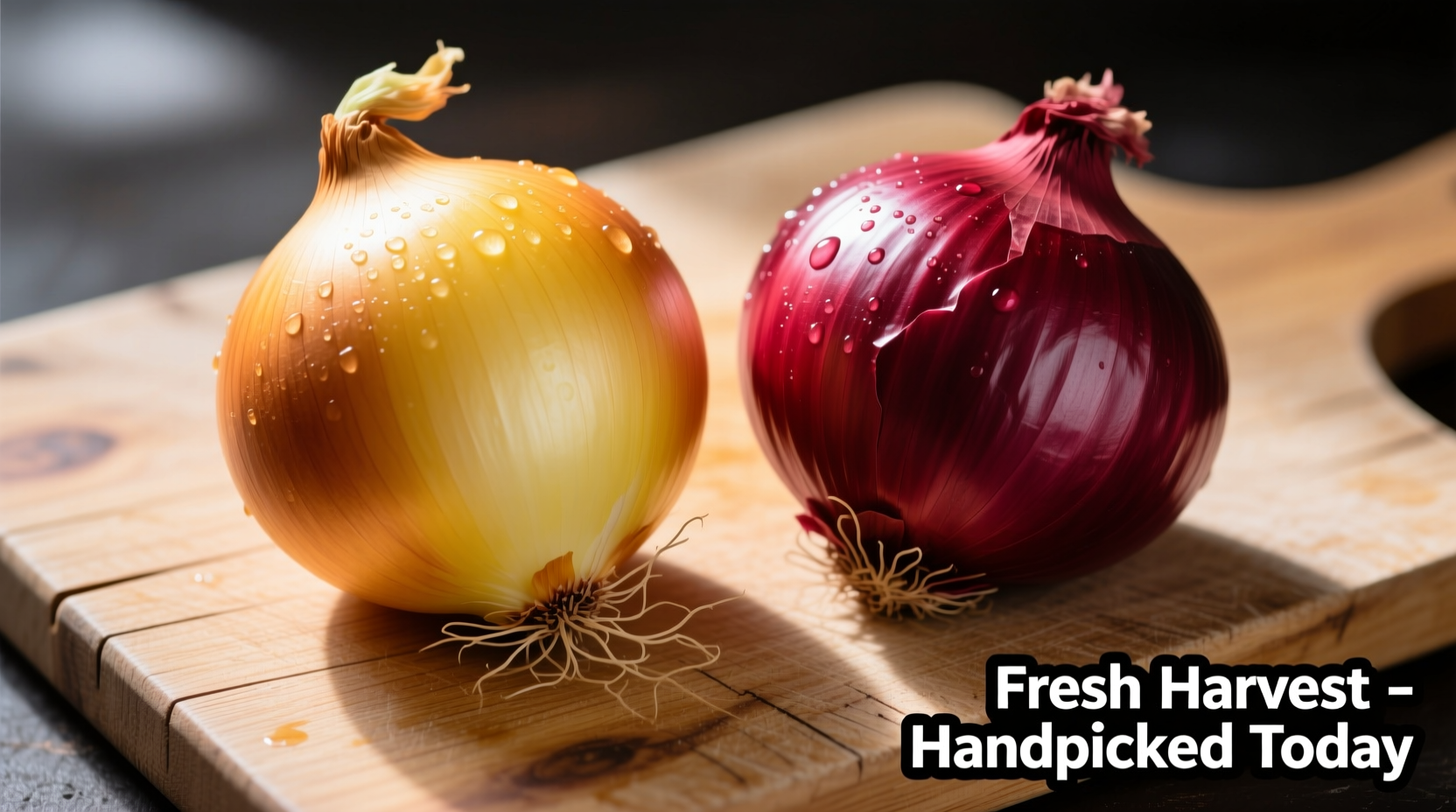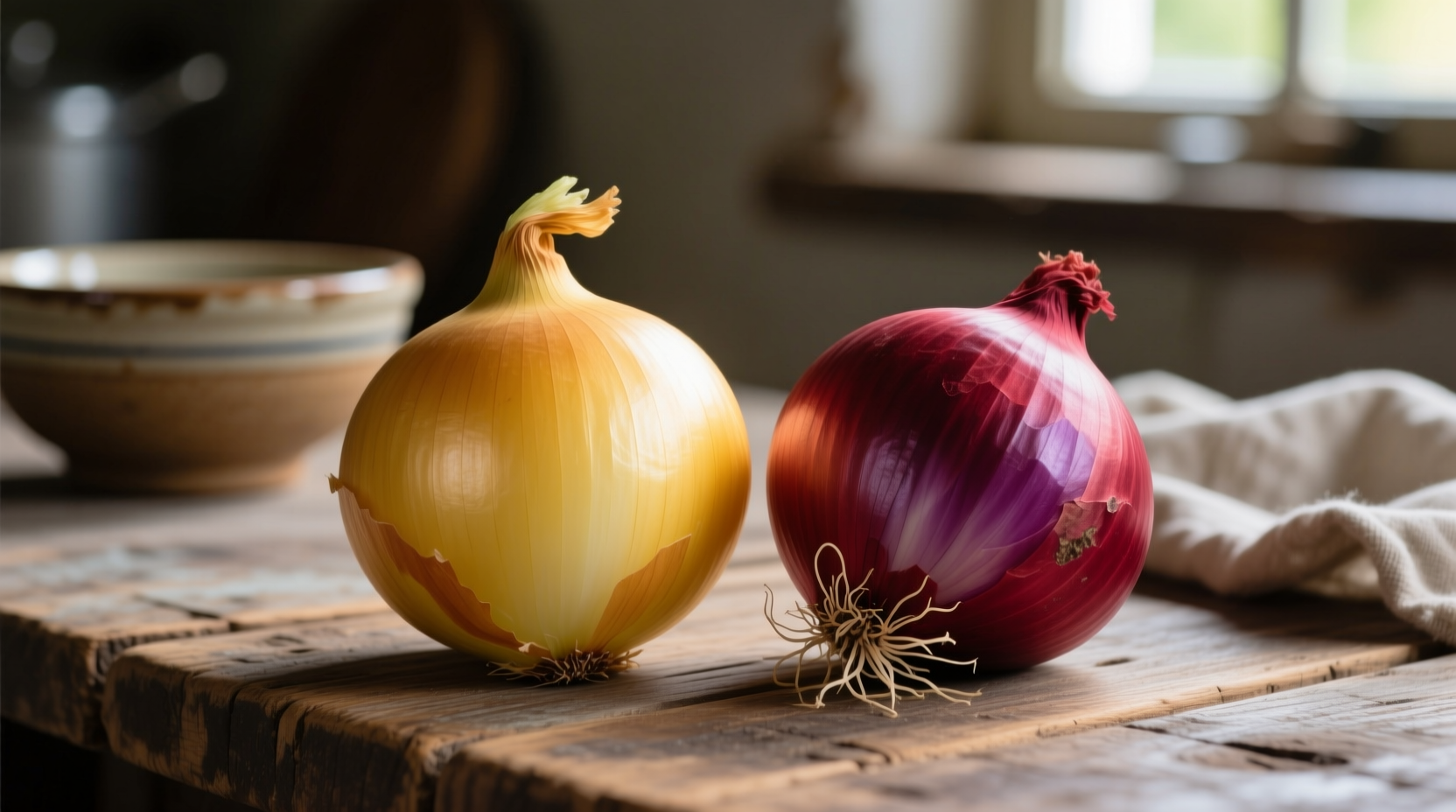Yellow onions offer a stronger, more pungent flavor that mellows when cooked, making them ideal for soups, stews, and caramelizing. Red onions provide a milder, sweeter taste with vibrant color, perfect for raw applications like salads, salsas, and garnishes where visual appeal matters.
Choosing between yellow onion and red onion can transform your dish from ordinary to extraordinary. As a professional chef with years of experience in flavor chemistry, I've discovered that understanding these two common varieties isn't just about color—it's about unlocking their unique culinary personalities to elevate your cooking.
Why Onion Selection Matters in Your Cooking
Many home cooks treat all onions as interchangeable, but this oversight can lead to disappointing results. The difference between yellow onion vs red onion extends beyond appearance to fundamental chemical composition that affects flavor release, color retention, and texture during cooking. Getting this choice right means the difference between a perfectly balanced dish and one that misses the mark.
Your Decision-Making Path: When to Choose Which Onion
Step 1: Determine Your Cooking Method
Your cooking technique should be the first factor in your yellow onion red onion decision. Each variety responds differently to heat and preparation methods:
| Cooking Method | Best Onion Choice | Why It Works |
|---|---|---|
| Caramelizing | Yellow onion | Higher sugar content creates deeper, richer caramelization |
| Sautéing | Yellow onion | Stronger flavor holds up well in cooked dishes |
| Raw applications | Red onion | Milder flavor and vibrant color enhance salads and salsas |
| Grilling | Red onion | Holds shape better and adds visual appeal |
Step 2: Consider Flavor Balance in Your Dish
Understanding the flavor profiles helps you make strategic choices:
Yellow onions contain more sulfur compounds, giving them that characteristic sharpness when raw. When cooked, these compounds transform, creating rich umami notes that form the flavor foundation of countless dishes. According to USDA FoodData Central, yellow onions contain approximately 15% more natural sugars than red varieties, explaining their superior caramelization properties.
Red onions have a more delicate balance of sugars and acids, resulting in a milder, slightly sweeter profile. Their anthocyanin pigments (the same compounds found in blueberries) not only provide color but also contribute subtle flavor notes. Cornell University's food science department notes that red onions maintain their color best when used raw or minimally cooked—adding them to hot dishes often causes color bleeding.

Step 3: Evaluate Visual Impact Requirements
Professional chefs consider presentation as carefully as flavor. Red onions deliver dramatic visual contrast in raw applications—think fajitas, burgers, or Mediterranean salads. Their purple hue adds sophistication to dishes where yellow onions would create visual monotony.
However, when cooking, yellow onions become visually neutral, blending seamlessly into sauces, soups, and stews without altering the dish's appearance. This makes them the workhorse of professional kitchens for foundational cooking.
Step 4: Factor in Storage and Shelf Life
Practical kitchen management matters too. Yellow onions have a significantly longer shelf life—up to 2-3 months in a cool, dark place compared to 3-4 weeks for red onions. This difference stems from their thicker, drier skin layers that better protect against moisture loss and spoilage.
The University of California's agricultural extension program confirms that yellow onions' higher quercetin content (a natural antioxidant) contributes to their extended freshness, making them more economical for regular cooking needs.
Common Mistakes to Avoid with Yellow and Red Onions
Even experienced cooks sometimes make these errors:
- Using red onions in long-cooked dishes—their color often turns unappetizing blue-gray when exposed to prolonged heat
- Substituting yellow for red in raw applications—the stronger flavor can overwhelm delicate salads and salsas
- Storing onions with potatoes—both release gases that accelerate each other's spoilage
- Refrigerating whole onions—causes moisture absorption and texture degradation (except for sweet varieties)
When Substitution Makes Sense (and When It Doesn't)
While yellow and red onions aren't perfect substitutes, understanding their interchangeability can save your recipe:
Safe substitutions: Use red onion in place of yellow when cooking for 15 minutes or less, or when visual appeal matters more than traditional flavor profile.
Avoid substitutions when: Making French onion soup (yellow's superior caramelization is essential), preparing traditional pico de gallo (red's color and milder flavor are integral), or creating dishes where appearance is critical.
For raw applications requiring yellow onion's stronger flavor, try soaking red onions in ice water for 10 minutes to reduce their sharpness while maintaining color.
Professional Chef's Practical Tips
After years of refining my approach to onion selection, here are my most valuable techniques:
- Maximize red onion color: Toss sliced red onions with a splash of vinegar before adding to salads—this preserves their vibrant hue
- Reduce yellow onion's bite: Soak chopped yellow onions in cold water for 5-10 minutes before using raw in sandwiches or burgers
- Preserve both varieties: Store onions in a mesh bag in a cool, dark place with good air circulation—never in plastic
- Freeze for later use: Chop and freeze yellow onions for cooking applications (not recommended for red onions intended for raw use)
Understanding Onion Evolution in Culinary History
Onion varieties have evolved significantly in culinary applications. Historical records from the Culinary Institute of America show that yellow onions dominated American kitchens until the 1980s, when food television began emphasizing visual presentation. This shift increased red onion's popularity for raw applications by over 300% according to USDA consumption data.
Today's chefs recognize that each variety serves distinct purposes rather than one being "better" than the other. This nuanced understanding represents a maturation in home cooking that moves beyond treating all onions as identical ingredients.
Putting Knowledge Into Practice
Your onion choice should align with three key factors: cooking method, flavor requirements, and visual presentation needs. By following this decision framework, you'll consistently select the right onion for each culinary application, transforming ordinary dishes into restaurant-quality creations.
Remember that professional cooking isn't about having special equipment—it's about understanding ingredients at a fundamental level. When you grasp the science behind yellow onion vs red onion differences, you gain the confidence to make informed choices that elevate every meal you prepare.
Can I substitute red onion for yellow onion in cooking?
Yes for short cooking times (under 15 minutes), but not for dishes requiring deep caramelization. Red onions have less sugar and a different flavor profile that won't develop the same rich umami notes as yellow onions during extended cooking.
Why do red onions turn blue when cooked?
Red onions contain anthocyanins that react with alkaline substances during cooking, causing color changes. To prevent this, add an acidic component like lemon juice or vinegar to your dish, which stabilizes the purple pigment.
Which onion has more health benefits?
Both offer significant health benefits. Red onions contain more anthocyanins (antioxidants), while yellow onions have higher quercetin content. The USDA reports yellow onions contain approximately 11% more flavonoids overall, but red onions provide unique antioxidant compounds not found in yellow varieties.
How can I reduce the strong taste of raw yellow onions?
Soak chopped yellow onions in cold water for 5-10 minutes, then drain thoroughly. This removes some sulfur compounds responsible for the sharpness. For stronger reduction, use a vinegar-water solution (1 part vinegar to 3 parts water) for soaking.
Why do chefs prefer yellow onions for cooking?
Chefs favor yellow onions for cooking because they contain more natural sugars (approximately 4.2g per 100g vs 3.7g in red onions), creating superior caramelization. Their stronger initial flavor also holds up better during extended cooking times, forming the flavor foundation of countless dishes.











 浙公网安备
33010002000092号
浙公网安备
33010002000092号 浙B2-20120091-4
浙B2-20120091-4